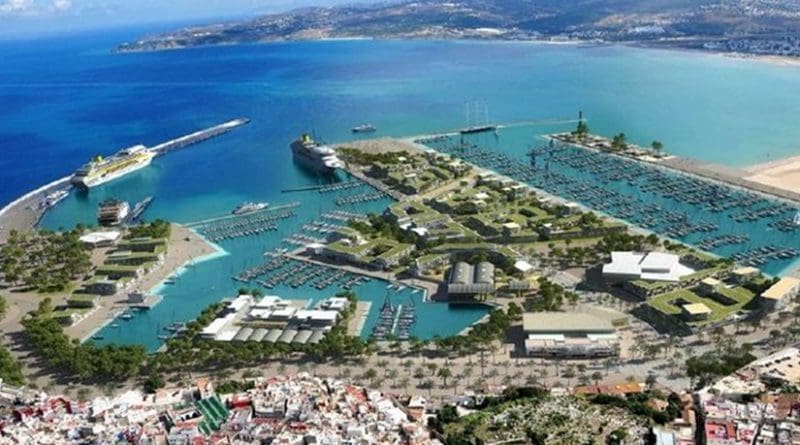Tangier’s Port Reconversion To Allow City To Become Leading Destination For Tourism – OpEd
The Port of Tanger Ville is located at the entrance of the Strait of Gibraltar, on the western edge of the city’s roads of Tangier, open facing the northwest.
Located in the city of Tangier, Morocco’s main maritime gateway to the Mediterranean, the port of Tangier is located at the junction of the Atlantic Ocean and the Mediterranean Sea in a bay between Cap Spartel and Cap Malabata.
On September 28, King Mohammed VI visited various worksites of the Tanger-ville port reconversion, carried out with an investment of 6.2 billion DH. The Sovereign visited the worksites of the Medina wall rehabilitation, the new marina and the fishing port. Extending over 84 hectares, the Tanger-ville port zone reconversion project, which started in March 2011, seeks to make the city of Tangiers a flagship destination for cruising and yachting tourism in the Mediterranean by developing several poles (cruising, yachting, fisheries, hotels, culture and conferences, trade, residences and offices)
In conformity with the instructions of HM the King, the project, to be completed end of 2016 will help secure an optimum reconversion of the site while respecting the rich history of the city of Tangiers, integrating the port in the city landscape and promoting environment-friendly development.
The port area will have several major facilities for the world’s largest cruise ships, expected to bring to Morocco around 300,000 tourists in 2016 and 750,000 in 2020.
The Tanger-ville port is also expected to become the Gibraltar strait’s port that extends the best services to sailors and sailing ships and integrated services that include ship repair, wintering, sailing ships sale and schools for sailing activities.
Another main component of the project is the building of a new fisheries port to improve the work conditions of professionals through modern installations, re-launching investments and creating jobs in the fisheries sector.
The new port will entail major economic and social impacts as it will comprise docks for high-sea fishing, an area for the maintenance of traditional, coastal and high-sea ships.
The fisheries port, where works were officially launched by HM the King in December 2011, is expected to be completed by June 2014.
In accordance with the instructions of HM the King, the Tangiers-Ville port area reconversion is conceived in a manner that respects its neighborhood and the city’s architecture.
Archeological and technical studies are ongoing for the rehabilitation of the old city’s wall.
In parallel to these works, some of the old fences and buildings located at the port entry were demolished.
Several hotels and a conference center are also scheduled, in addition to shops, a mall, residence buildings, offices and an aerial tramway.
The ambitious reconversion program, a new opportunity to give new life to the Tangiers-ville port, will consolidate the tourism calling of the city.
The Port of Tanger Ville is located at the entrance of the Strait of Gibraltar, on the western edge of the city’s roads of Tangier, open facing the northwest. Located in the city of Tangier, Morocco’s main maritime gateway to the Mediterranean, the port of Tangier is located at the junction of the Atlantic Ocean and the Mediterranean Sea in a bay between Cap Spartel and Cap Malabata.
This unique and strategic position gave the port of Tangier the status of first Moroccan port for passenger and TIR traffic. Known for regular routes connecting various European ports such as Algeciras, Tarifa and Barcelona in Spain, Sete, Marseille and Port Vendres in France, and Genoa in Italy, the Port of Tangier stands out from other ports because of the free zone located in its storage areas and additional high added value goods.
With the commissioning of the new Tanger Med port, located 40 km east of Tangier, almost all the traffic of the port of Tangier was transferred progressively from late 2008 until late 2010.
A port redevelopment project, led by the Société d’Aménagement du Port de Tanger, was initiated in 2010, aiming to give the port a new function oriented towards cruise tourism and yachting.
The port’s conversion work started in 2011, and is scheduled to end in 2016, allowing the city of Tangier to become a leading destination for tourism.
Background History
The origin of the port dates back to the seventeenth century, when the English built a 225 m long, 33 m wide mooring pier that was later destroyed in 1684. A coal depot concession for steamers was built in July 1895 and the first wooden pier soon followed in 1897. The new dock improved conditions for landing passengers and goods. Between 1903 and 1908 a port for barges and small sailboats was built; it was composed of a 340 meters long jetty protecting it against the northwest swells. In 1921, a Decree by the Cherifian Government granted the “Société du port de Tanger” the exclusive right to build, maintain and operate the port of Tangier. Between 1925 and 1933, the “Société du port de Tanger’ created many additional extensions including a breakwater 960 m in length, a 300 m long intermediate retaining wall, a platform for coal and fuel oils, and several other jetties.
Additionally, dredging was carried out at -3.5 m and -4 m within the coastal navigation basin, underwater earthwork was undertaken to create an anchorage area at -8 meters BCD as well as an oil wharf and a service wharf. In 1967, the government ended the concession granted to the “Société du Port de Tanger” and decided to entrust the management of the port to the RAPC. In 1985, management was entrusted to the Exploitation des Ports then to the Morocco Port Authority (Agence Nationale des Ports) in 2006. On December 15, 2010, by Ministerial Order, the port of Tanger Ville was closed to commercial ships. Today it only accommodates cruise ships and high speed ferries connecting to Tarifa (in the south of Spain).

